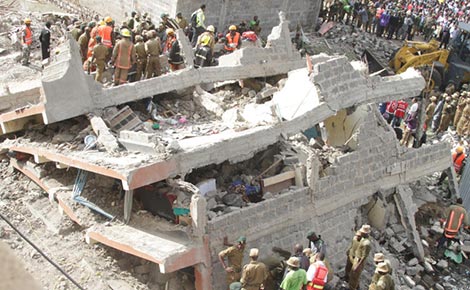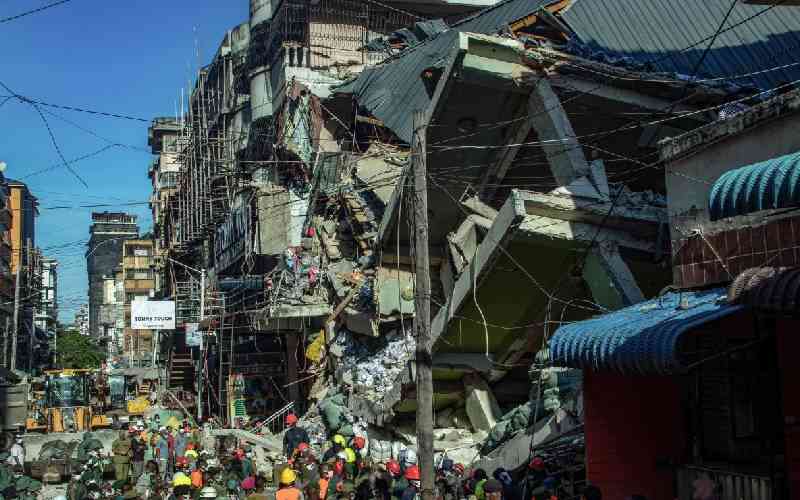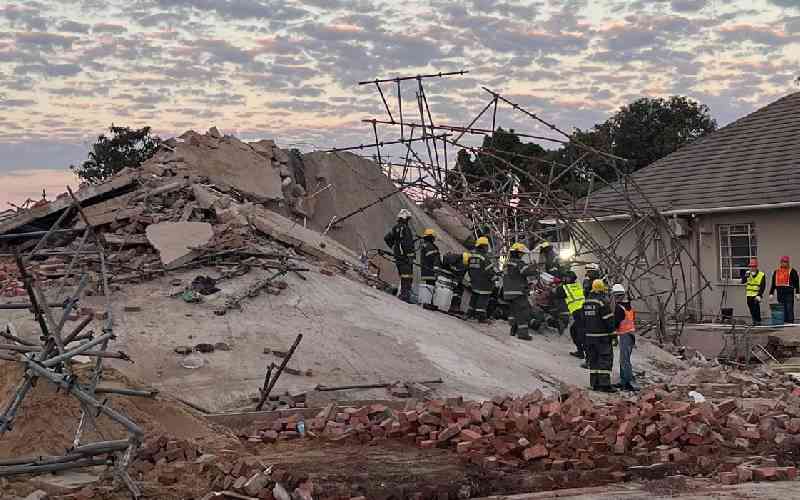 |
|
The building that collapsed last week in Makongeni, Nairobi. [PHOTO: FILE / STANDARD] |
A day after a five-storey building collapsed in Nairobi's Kaloleni area, killing seven people, county officials visited the scene and marked some buildings in the neighbourhood for demolition.
The building that collapsed last week was allegedly constructed on a wetland, which was said to be have been a playground.
The area residents association claimed they had reported the grabbing of the land to the authorities two years ago but no action was taken.
Last week, Nairobi deputy governor revealed that the owner did not have occupation licence. By the time of the collapse, a sixth floor was under construction while people were living on the other floors.
We hear such revelations every time a building collapses. The marking of a few neighbouring buildings by county officials was part of the usual script we have seen in similar moments.
The sad thing is that city fathers know the root cause of the problem, but are reluctant to tackle it.
In 2011, the Architectural Association of Kenya released a study on development control in Kenya.
The study revealed that developers were the greatest violators of development control laws and regulations, accounting for 57 per cent of all violations.
Local authority staff were blamed for 32 per cent of rule breaking, while 11 per cent was attributed to built environment professionals like architects, planners, and engineers.
From field interviews conducted in 17 local authorities (in 14 counties), the study established that the main reason for such violations was developers' quest to maximise profits.
"Developers exceed the density approved, resulting in higher built-up areas of a zone than planned for in the development plan," said the report.
It blamed the now defunct local authorities for failing to enforce by-laws because of political interference, inadequate technical capacity, partisanship, and hostile developers as well as the hostile public. If caught, the violators escaped with only a slap on the wrist.
The leading consequences of non-compliance included an unhealthy living environment (insecure, poorly-lit, poorly-ventilated, and poor solid waste disposal) and lack of children's play areas.
These were closely followed by collapse of buildings, frequent fire outbreaks, lack of parking space, built-up spaces not within minimum requirements, and lack of aesthetics (neighbourhood character as defined by zoning ordinances).
"When violation of development control occurs, amenities and interests of the larger community are sacrificed for the benefit of a few influential individuals," said the report.
Stay informed. Subscribe to our newsletter
It added: "The violations and the inability of local authorities to contain such violations impinge on residents' basic rights such as mobility, privacy, access to water, security, and property value."
The study found that 56 per cent of developers carry on with their construction without the supervision of local authority staff and that there is no organised system of tracking developers in most local authorities and thus it was difficult to get data on ongoing projects and illegal developments.
Things were made worse by infiltration of the sector by unqualified people whose presence would only be noticed when the effects of poor workmanship – collapsing buildings, fire outbreaks, lack of access roads, lack of children's playing grounds – set in.
These facts are as true today as they were two years or a decade ago. There are many construction works going on in Nairobi and other towns without the knowledge of county officials. All this is happening in broad daylight.
Sadly, all this is going on at a time the industry boasts having new regulatory entities like the National Construction Authority.
[email protected]
 The Standard Group Plc is a
multi-media organization with investments in media platforms spanning newspaper
print operations, television, radio broadcasting, digital and online services. The
Standard Group is recognized as a leading multi-media house in Kenya with a key
influence in matters of national and international interest.
The Standard Group Plc is a
multi-media organization with investments in media platforms spanning newspaper
print operations, television, radio broadcasting, digital and online services. The
Standard Group is recognized as a leading multi-media house in Kenya with a key
influence in matters of national and international interest.
 The Standard Group Plc is a
multi-media organization with investments in media platforms spanning newspaper
print operations, television, radio broadcasting, digital and online services. The
Standard Group is recognized as a leading multi-media house in Kenya with a key
influence in matters of national and international interest.
The Standard Group Plc is a
multi-media organization with investments in media platforms spanning newspaper
print operations, television, radio broadcasting, digital and online services. The
Standard Group is recognized as a leading multi-media house in Kenya with a key
influence in matters of national and international interest.









